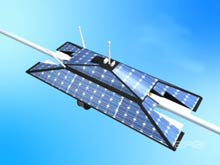High-Wire Robot to Inspect the Grid
A robot designed to crawl along tens of thousands of miles of transmission lines could help inspect North America’s vast and aging grid infrastructure without the need for manned helicopters inspections.

Researchers at the Electric Power Research Institute, an independent nonprofit research organization for the utility sector, have designed a 140-pound, six-foot-long prototype of a robot that they plan to test for the first time at an outdoor lab later this month. The device uses rollers to clamp onto and move along a line. It can maneuver past towers, known as pylons, using cables built into newer towers or retrofitted onto old ones. “There is nothing that does what it does; nothing that even tries,” said Andrew Phillips, director of power transmission research at the institute.
The rectangular robot–looking a bit like a scaled down version of a solar car–is equipped with a high-definition camera and sensors that can detect overgrown trees. “It will do image analysis to see if there is something different with the structure compared to an earlier picture taken from the exact same spot,” says Phillips. Being able to remotely spot high-risk trees, which are the top cause of electrical outages, is important to utilities. The big August 2003 blackout was triggered by a poorly trimmed tree. “The images will be very high-definition, and we’ll be able to zoom in,” Phillips adds.
The prototype robot will also make sure there are no faulty connections that can cause overheating, and listen for electromagnetic “noise” that might indicate other problems with equipment. It could also retrieve data from sensors that are already connected to equipment in the field but which normally rely on helicopter or ground visits to get the information.
Having the ability to look at the condition of equipment without physically being there will bring tremendous value to utilities, said Phillips. It’s too early to say how much the robot will cost, but Phillips figures it will be less than $500,000 each. “The expectation is that it’s going to be at least less than 70 percent of the cost (of using helicopters),” he says.
The device rolls at about three miles an hour along a high-lying “shield wire,” a wire that protects the main transmission lines below from lightning strikes. Initially, the plan to power the robot involved covering its surface with solar cells that would charge a lithium polymer battery inside. “We decided instead to harvest power flowing through the shield wire itself,” says Phillips, who explains that the shield wire picks up some power flow from the nearby transmission lines through electromagnetic induction. Solar cells will still be used for backup power, however.
In the most remote areas, raw data that has been collected will be sent back to the utility through a satellite link. Higher bandwidth information, such as digital images, will be transmitted through cell-phone signals when the robot gets closer to population centers. Phillips figures that each robot will be capable of covering 80 miles of line twice a year.
George Juhn, director of investment planning and asset management at Ontario transmission giant Hydro One, notes that aerial drones are also being tested by the industry as a way to collect data about remote power lines. “A device such as [the new robot] does need to go through extensive testing to ensure it provides reliable information,” he says, adding “It would definitely be of interest to us.”
Phillips says the problem with aerial drones is that the U.S. Federal Aviation Authority has strict rules on how and when they can be used because of the potential impact if they malfunctioned. A line-crawling robot poses less of a threat and can travel the lines all year and, if necessary, even at night.
But Phillips agrees that much more testing is needed. He says the first commercial test is expected to take place as early as 2014 along the Potomac-Appalachian Transmission Highline, a new 275-mile transmission corridor being built by Allegheny Energy and American Electric Power in Columbus, OH.
Keep Reading
Most Popular
Large language models can do jaw-dropping things. But nobody knows exactly why.
And that's a problem. Figuring it out is one of the biggest scientific puzzles of our time and a crucial step towards controlling more powerful future models.
The problem with plug-in hybrids? Their drivers.
Plug-in hybrids are often sold as a transition to EVs, but new data from Europe shows we’re still underestimating the emissions they produce.
Google DeepMind’s new generative model makes Super Mario–like games from scratch
Genie learns how to control games by watching hours and hours of video. It could help train next-gen robots too.
How scientists traced a mysterious covid case back to six toilets
When wastewater surveillance turns into a hunt for a single infected individual, the ethics get tricky.
Stay connected
Get the latest updates from
MIT Technology Review
Discover special offers, top stories, upcoming events, and more.